Caves and Rock Shelters with Wall Paintings and Engravings
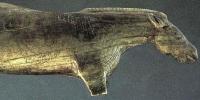
Overview of Cave Paintings and Sculptures

The Rock Drawings of Alta constitute the most important piece of evidence in favour of the existence of human activity in the confines of the Great North during the prehistoric period. Close to the Arctic Circle, they are a valuable illustration of human activity between 6 200 and 2 500 BP in the Northern Hemisphere. They are primordial evidence of the fauna, representing reindeer, elks, bears, dogs and/or wolves, foxes, hares, geese, ducks, swans, cormorants, halibut, salmon and whales, and of the environment. They also depict boating, hunting, trapping and fishing scenes, as well as people taking part in dances and ritual acts.
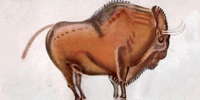
Altamira Cave is 270 metres long and consists of a series of twisting passages and chambers, and is decorated with ice age paintings. The artists used charcoal and ochre or haematite to create the images. They also exploited the natural contours in the cave walls to give their subjects a three-dimensional effect. The Polychrome Ceiling is the most impressive feature of the cave, depicting a herd of extinct Steppe Bison in different poses, two horses, a large doe, and possibly a wild boar. Around 13 000 years ago a rockfall sealed the cave's entrance, preserving its contents until its eventual discovery.
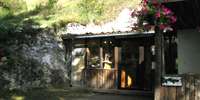
La Grotte de Bara Bahau is an Historic Monument containing Ice Age Cave Art. It is 100 metres long, 12 metres wide, and up to six metres high. There are many scratches on the walls from the Cave Bears which once inhabited this limestone cave. Magdalenian hunters left engravings of horses, bison, deer, aurochs, human hands, a phallus, and bears, as well as signs whose meaning we can only guess at. The cave itself was well known for many years, but the engravings were discovered in April 1951 when the famous caver Norbert Casteret in company with his son Raoul and his daughter explored the cave thoroughly and discovered the Magdalenian engravings. These were authenticated by Henri Breuil in August of that year. Later, in 1955 Father Glory made a thorough examination of the cave, and in 1997 Brigitte and Gilles Delluc published a monograph on the cave.
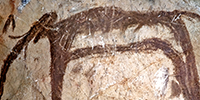
In 1940 at Baume-Latrone, or Latrone Cave, drawings from the Upper Palaeolithic were discovered in a deep network 240 metres from the entrance.
They have a unique style, and have been assigned to the Aurignacian. They have been dated to 37 464 BP (cal).
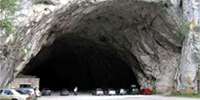
Grotte de Bédeilhac has a huge entrance and was a good shelter for Magdalenian hunters. There are two horizons with human remains.
Important finds include clay sculptures, bone polishers, baguettes demi-ronde, perforated horse teeth and many paintings and engravings on the walls.
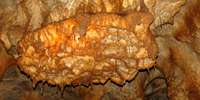
Grotte de Bernifal is a cave decorated with over 100 engravings and paintings. It includes engravings of horses, bison, mammoths and ibex as well as the enigmatic tectiform (roof shaped) drawings seen in many other caves of the same period. It has changed very little in more than twelve thousand years, and has not been vandalised, since the original entrance was blocked with rubble soon after the last artists left.
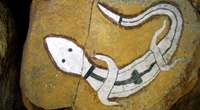
The Blue Hole on the Gara River is the location of an aboriginal art site on the Northern Tablelands of NSW Australia, which includes paintings of a lizard, a snake, and hand stencils. It appears to be regularly maintained and cared for by local aboriginal people as part of a continuing tradition.

Monte Buciero has around 20 caves and small abris or rock shelters. Human occupation is known in at least seven of these caves. Engravings have been found in two of them - Peña del Perro and Cueva de San Carlos, also known as Cueva del Fortín.
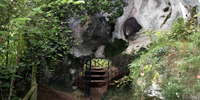
El Buxu Cave was discovered by chance in December 1916 by Cesáreo Cardin, an habitual collaborator in the archaeological digs of Hugo Obermaier and Conde de la Vega del Sella. There are a number of paintings and engravings of animals in this cave. The entrance is formed by an outer vestibule six metres wide and five metres deep, facing south-west. The original rock-shelter, however, was much larger, as is shown by the presence of numerous blocks of limestone which have collapsed from the roof, and the remains of a former floor, partially eroded away. This former rock-shelter would have faced south, situated 300 metres above present-day sea level, and 25 metres above the valley floor.

The Cueva de El Castillo, or the Cave of the Castle, is an archaeological site within the complex of the Caves of Monte Castillo, and is located in Puente Viesgo, in the province of Cantabria, Spain. This cave was discovered in 1903 by Hermilio Alcalde del Río, the Spanish archaeologist, who was one of the pioneers in the study of the earliest cave paintings of Cantabria. In the time of the cave painters, the entrance to the cave was not as large as it is today, because it was enlarged by the excavations in the front of the caves. By way of the entrance one can access the different rooms in which Alcalde del Río found an extensive sequence of images. The paintings and other markings span from the Lower Palaeolithic to the Bronze Age, and even into the Middle Ages. There are over 150 figures already catalogued, including engravings of deer, complete with shadowing.
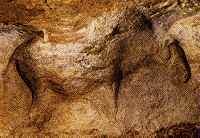
L'Abri du Cap Blanc - Over 15 000 years ago, Ice Age hunters carved horses, bison and reindeer, some of which are over two metres long, straight into the Limestone cliffs at Cap Blanc. The abri, which was discovered in 1909, is today the only frieze of prehistoric sculptures in the world to be shown to the public.

Blombos Cave is on the south coast of South Africa. The evidence indicates periods of relatively brief occupation separated by long periods of non-occupation, including a separation between occupation during the Late Stone Age (LSA) and the Middle Stone Age. Bone tools, marine shell beads, and engraved ochre were found in the M1 phase, bone tools in the Upper M2 phase, and considerable quantities of ochre and associated ochre working tools in the M3 phase. Very approximate dates are: M1: 73 000 BP, M2: 80 000 BP, M3: 100 000 BP.
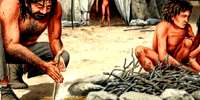
The Côa Valley in Portugal has the most exceptional concentration of rock carvings from the Upper Palaeolithic. It is the most outstanding example of early human artistic activity in this form anywhere in the world, and has been designated a UNESCO world heritage site.
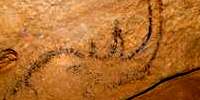
The oldest cave paintings in Central Europe, estimated at between 23 000 and 35 000 BP, have been discovered by a team of Romanian speleologists at the Coliboaia Cave, Romania.
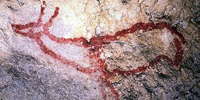
Covalanas cave in Cantabria, Spain, was first discovered to have art work in 1903. It is situated on the South-Western hillside of Pando mountain, near the cave of el Míron. Although the entrance is not huge, access is easy. From the entrance two galleries continue, though only one of them has palaeolithic decoration. In a deep zone of the gallery, and in a space less than 12 metres in length, the largest group of art in the cave is located. It has 22 figures, of which 18 are hinds , a characteristic animal in the Cantabrian decorated caves, as well as a horse, a reindeer and an aurochs. The paintings are between 20 000 and 14 400 years old.
 The archaeological cave site of El Mirón is located in the Rio Asón valley of eastern Cantabria, Spain. The cave opening is about 260 metres above sea level, and the cave opening is about 13 metres high, 8-16 metres wide, and 120 metres deep. A red deer stag shoulder blade found there bears the engraved image of the head, neck and part of the dorsal line of a red deer hind. El Mirón is remarkable for its long occupation history and thus for its long unbroken sequence of history and prehistory of Cantabria, Spain. The site includes human occupations between the Middle Paleolithic (circa 41 000 years ago) to 1400 AD, including Mousterian, Early Upper Paleolithic, Solutrean, Magdalenian, Azilian, Mesolithic, Neolithic, Chalcolithic, and Bronze Age deposits.
The archaeological cave site of El Mirón is located in the Rio Asón valley of eastern Cantabria, Spain. The cave opening is about 260 metres above sea level, and the cave opening is about 13 metres high, 8-16 metres wide, and 120 metres deep. A red deer stag shoulder blade found there bears the engraved image of the head, neck and part of the dorsal line of a red deer hind. El Mirón is remarkable for its long occupation history and thus for its long unbroken sequence of history and prehistory of Cantabria, Spain. The site includes human occupations between the Middle Paleolithic (circa 41 000 years ago) to 1400 AD, including Mousterian, Early Upper Paleolithic, Solutrean, Magdalenian, Azilian, Mesolithic, Neolithic, Chalcolithic, and Bronze Age deposits.

Carnarvon Gorge - an Aboriginal Rock Stencil Art site, with engravings of vulvas, emu and kangaroo tracks.
Carnarvon Gorge lies within the spectacular and rugged ranges of Queensland's central highlands. The fragile aboriginal art on the gorge's sandstone walls reflects a rich culture. Ochre stencils of tools, weapons, ornaments and ceremonial objects, as well as engravings and grooves where tools were sharpened provide an insight into the lives of the gorge's first people.

This is a very important set of sites within a small area. A number of engravings and paintings have been found here. The site of Castel-Merle is also known as Vallon des Roches, and is located near the town of Sergeac on the Vézère River between Lascaux and the shelter of Moustier, near Les Eyzies-de-Tayac.
It includes l'abri Blanchard, l'abri Castanet, l'abri Castanet II, l'Abri des Merveilles, l'abri Blanchard I and II, l'abri Reverdit, l'abri du Roc de l'Acier, l'abri Labattut and l'abri de la Souquette.
This prehistoric site has the distinction of having its own museum where there are many artefacts from the various excavations of rock shelters, with six necklaces dating from the Aurignacian and Magdalenian (among the oldest in Europe). The Vallon des Roches has a unique geological formation. It consists of high parallel cliffs closer than 100 metres and comprising six shelters spread over 400 metres, giving one of the highest concentrations of prehistoric settlements of Aquitaine, from Neandertals to the Magdalenian. The overhanging parts of these shelters have collapsed, mainly towards the end of the last glaciation, and thus ensured very good protection for the archaeological layers.
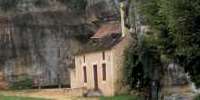
Les Combarelles in the Dordogne, with more than 600 images on its walls, most of them engraved, is considered to be one of the major sanctuaries of Magdalenian culture. This extraordinary site was discovered in 1901. Beyond the entrance of the cave two galleries diverge. The largest one, now open to the public, is a narrow and winding passage, following a zig zag pattern for more than 240 metres. The animals represented are finely engraved. A diverse fauna is represented, including horses, reindeer, ibex, mammoths, rhinoceros, bears, lions and a few bisons and aurochs.

The Grottes de Cougnac caves are near Gourdon, Lot. The site consists of two caves separated by 200 metres. The first contains many concretions, some very fine, called soda straws. The second is a decorated cave from the Paleolithic. The cave has many prehistoric paintings dated to the upper Paleolithic. Depictions include deer, megaceros, the ibex, and mammoths as well as various schematic human figures. The paintings corresponded to at least two clearly distinct phases: one around 25 000 BP, the other about 14 000 years before the present.
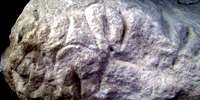
Le Ruth and Le Cellier - Sous le Ruth is the house beneath the archeological site, le Ruth, near le Moustier, and is a private gisement, with a good display of stone tools, and access to the excavated site of le Ruth. Le Cellier is an important site a few hundred metres away, which yielded many Aurignacian tools, and stone engravings of vulvas and of ibex, as well as a pointillist engraving of a mammoth.
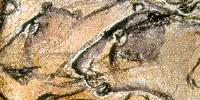
Chauvet Cave in the valley of the Ardèche River in France is filled with paintings, engravings and drawings created more than 30 000 years ago, of cave lions, mammoths, rhinos, bison, cave bears and horses. It contains the earliest known cave paintings, as well as other evidence of Upper Paleolithic life. It is situated on a limestone cliff above the former bed of the Ardèche River. The later Gravettian occupation, which occurred 25 000 to 27 000 years ago, left little but a child's footprints, the charred remains of ancient hearths and carbon smoke stains from torches that lit the caves. After the child's visit to the cave, evidence suggests that the cave had been untouched until discovered in 1994. The footprints may be the oldest human footprints that can be dated accurately

Cussac Cave or Grotte de Cussac contains over 150 Paleolithic artworks as well as several human remains. It is located in the Dordogne River valley. The cave was discovered on September 30, 2000. The cave's artworks are estimated to be 25 000 years old, and are almost exclusively engravings, often very large, made with stone tools on the walls, or with fingers on clay soil. Pigments are limited to very few red dots. They include both classic instances of Upper Paleolithic animal art (bison, horses, mammoths, rhinoceroses, ibex) and rarer images including birds, enigmatic figures, and perhaps four female profiles.

The Gorge d'Enfer is on the right bank of the Vézère River near Les Eyzies-de-Tayac, and contains L'Abri Poisson. The shelter was discovered in 1892 by Paul Girod, and dates from the Aurignacian. In 1912 Jean Marsan identified the fish carved in the ceiling of a small abri that made the site famous.
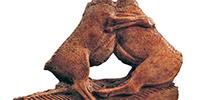
La Grotte d'Enlène, 200 metres long, is the longest known Volp cave, and was the subject of numerous excavations during the second half of the nineteenth century until the Second World War. However, it has long been ignored because the main findings of movable art that were made there have always been attributed to les Trois Frères, with which it communicates by a narrow passage. However, one of the major interests of Enlène is that it is a cave-habitat with a high occupancy rate during the Magdalenian IV, while Les Trois-Frères was a cave-shrine and has never been used as a habitat, at least in the long term and delivered little movable art remains.

The Cave of Trois-Frères is a cave 427 metres long in southwestern France famous for its cave paintings. One of these, called 'The Sorcerer' is as familiar as any art in the more famous cave of Lascaux. The cave is part of a single cave-complex with the Tuc d'Audoubert, both galleries formed by the Volp River. The cave art appears to date to approximately 15 000 BP. The cave is named for the three sons of Comte Bégouen who discovered it in 1914. The drawings of the cave were made famous in the publications of the Abbé Henri Breuil.
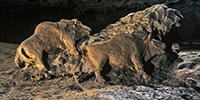 Tuc d'Audoubert, 640 metres long, may only be accessed via the stream, the Volp, which includes two impassable siphons. The cave of Tuc Audoubert was discovered by the sons of Count Henri Bégouën in 1912. Having been to Mas d'Azil, during the summer holidays of 1912, July 20, they decided to explore the resurgence of Volp using a raft they made, and thus discovered the cave of Tuc d'Audoubert and the first engravings. A prehistorian, Emile Cartailhac, a family friend, was called immediately and authenticated the drawings. On 10 October, through a narrow gap which became known as the catflap, with the help of their friend François Camel, they penetrated the upper galleries at the bottom of which awaited the clay bisons!
Tuc d'Audoubert, 640 metres long, may only be accessed via the stream, the Volp, which includes two impassable siphons. The cave of Tuc Audoubert was discovered by the sons of Count Henri Bégouën in 1912. Having been to Mas d'Azil, during the summer holidays of 1912, July 20, they decided to explore the resurgence of Volp using a raft they made, and thus discovered the cave of Tuc d'Audoubert and the first engravings. A prehistorian, Emile Cartailhac, a family friend, was called immediately and authenticated the drawings. On 10 October, through a narrow gap which became known as the catflap, with the help of their friend François Camel, they penetrated the upper galleries at the bottom of which awaited the clay bisons!
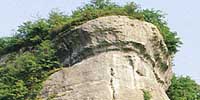
Font-de-Gaume is a cave near Les Eyzies. The cave contains prehistoric polychrome cave paintings and engravings. The paintings were discovered by Denis Peyrony, a local schoolmaster, on 12 September 1901. The cave had been known to the general public before this, but the significance of the paintings had not been recognised. The paintings in the cave at Font-de-Gaume were the first to be discovered in the Périgord province. Prehistoric people living in the Dordogne Valley first settled in the mouth of Font-de-Gaume around 25 000 BC. The cave mouth was inhabited at least sporadically for the next several thousand years. The paintings date from around 17 000 BC, during the Magdalenian period. Many of the cave's paintings have been discovered in recent decades. The cave's most famous painting, a frieze of five bison was discovered accidentally in 1966 while scientists were cleaning the cave.
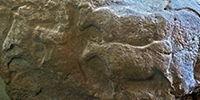
Fourneau du Diable is a prominent cliff face on the road leading to the east from the village of Bourdeilles, beside the river Dronne. It was once a settlement in the late Solutrean, and lithic and bone industries from that time were excavated there, but the most important discovery was of a large limestone block with several well executed sculptures of aurochs carved on its face.
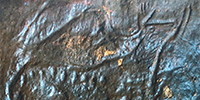
The small Grotte de la Forêt lies between Moustier and Tursac. It is at the junction of the valley of Fontpeyrine and the Vézère, between the cliffs of Reignac upstream and Lespinasse downstream. It houses a magnificently engraved reindeer, with its head erect, the antlers thrown backwards, the limbs in vertical extension. Details abound: eye underlined with a curved line, lower lip slightly turned down, nostrils, punctuated flank, as well as an abundant mane shown by parallel streaks, attributes of a male subject.

Lonetal Sites, including Neanderthal and Middle Paleolithic sites in the Swabian Alb near the city of Ulm, were important areas of ice age art. The sites occur in the Schwaebische Alb (Swabian Alb), in the valleys of the Ach and Blau river near Blaubeuren, where the famous lion/human figure was found in the Hohlenstein-Stadel cave. The sites include Vogelherd, where a large number of superbly crafted animal figurines were found, including the famous Vogelherd horse figurine made of mammoth ivory.
 Vogelherd cave is located on the edge of the Lone valley, about 1 km northwest of Stetten and northeast of the Alb-Donau county (Alb-Donau-Kreis). Vogelherd cave is a very scenic place and well worth a visit, as indeed is all of the Lone valley. The cave is not visible from the road and one must first walk over a ridge to gain access to the three entrances on the edge of the Lone valley. The cave covers an area of 170 square metres. This extremely important site, rich in finds, was first discovered when Stone Age artefacts turned up from a badger's burrow. The actual size of it only became apparent after the excavations by Gustav Riek in the summer of 1931. The finds range from the Middle Palaeolithic to modern times. The world-renowned ivory carvings originate from the Middle Aurignacian period.
Vogelherd cave is located on the edge of the Lone valley, about 1 km northwest of Stetten and northeast of the Alb-Donau county (Alb-Donau-Kreis). Vogelherd cave is a very scenic place and well worth a visit, as indeed is all of the Lone valley. The cave is not visible from the road and one must first walk over a ridge to gain access to the three entrances on the edge of the Lone valley. The cave covers an area of 170 square metres. This extremely important site, rich in finds, was first discovered when Stone Age artefacts turned up from a badger's burrow. The actual size of it only became apparent after the excavations by Gustav Riek in the summer of 1931. The finds range from the Middle Palaeolithic to modern times. The world-renowned ivory carvings originate from the Middle Aurignacian period.

The Mal'ta - Buret' venuses and culture in Siberia - the site of Mal'ta, is composed of a series of subterranean houses made of large animal bones and reindeer antler which had likely been covered with animal skins and sod to protect inhabitants from the severe, prevailing northerly winds. Among the artistic accomplishments evident at Mal'ta are the remains of expertly carved bone, ivory, and antler objects. Figurines of birds and human females are the most commonly found items.
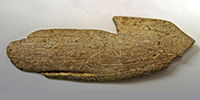
La grotte des Fées is located in the Moron valley near the cave of Pair-non-Pair. It is a small cave that has its opening at the top of a limestone cliff. F. Daleau undertook extensive excavations there and collected a handsome middle and upper Magdalenian lithic industry as well as faunal remains. The Roc de Marcamps was discovered just below the prehistoric cave of la grotte des Fées. It is a Magdalenien archaeological site, and a number of carvings including some athropomorphic shapes have been found there. Both these sites are very close to the cave of Pair-non-Pair.

The 200 engravings of the narrow Grotte de Gabillou , discovered in 1941, indicate a Magdalenian age. It is located in the valley of l'Isle, near Mussidan, France. The cave is in a sandy Maastrichtian limestone. Its northwestern end, once expanded by man and used as a storeroom, is obscured by a building. It was discovered in 1941 by M. Charmarty and M. Truffier.
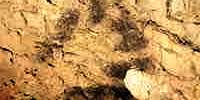
The cave art of Grotte de Gargas constitutes one of the most moving revelations today of the life and thoughts of our prehistoric ancestors. It is made up of two very important elements - painted hands, many apparently mutilated, as well as important animal engravings and paintings.
.
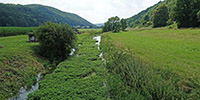 A number of world-wide famous caves, such as the Geissenklösterle, Brillenhöhle, Grosse Grotte, Sirgenstein and Hohle Fels cave, can be reached from Blaubeuren on a signed hiking path. I visited the area in the summer of 2018, and have added many photographs and a lot of extra text. A number of superb carvings of animals have been found at Geißenklösterle, and the Venus of Hohle Fels is the oldest venus figurine ever found.
A number of world-wide famous caves, such as the Geissenklösterle, Brillenhöhle, Grosse Grotte, Sirgenstein and Hohle Fels cave, can be reached from Blaubeuren on a signed hiking path. I visited the area in the summer of 2018, and have added many photographs and a lot of extra text. A number of superb carvings of animals have been found at Geißenklösterle, and the Venus of Hohle Fels is the oldest venus figurine ever found.

Gobustan on the Caspian Sea is a site dated to around 5 000 - 8 000 years BP, where there are paintings or etchings (petroglyphs) of what appear to be long boats in the style of the Viking ships of more recent times, as well as many other types, including human outlines, horses, and aurochs.
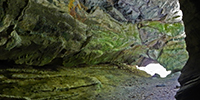
Gudenushöhle (Gudenus cave) is a very important Neanderthal site situated 20 km northwest of the city of Krems. The site is close to the River Danube. The cave is 22 m long with a width of 2 to 3 m. The archaeological deposit has yielded bones of numerous animals, including Woolly mammoth, Woolly rhinoceros, Aurochs, Chamois, Reindeer, and Red deer. Human artefacts include numerous flint implements beginning with the Mousterian (i.e. Neanderthals) of the Middle Palaeolithic, although there is no certainty as to the dating. There is also an Upper Palaeolithic, Magdalenian, assemblage including an engraved reindeer bone, and a fragment of a bone flute dated to about 18 000 – 12 000 BP.
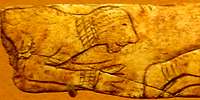
Les Grottes d'Isturitz et d'Oxocelhaya - The Caves of Isturitz and Oxocelhaya date back to the Mousterian, about 80 000 BC, and there is evidence of Neanderthals living there, but occupation extended to almost the end of the ice age in 10 000 BC. Isturitz is famous for the discovery of a series of important prehistoric flutes dating from the Upper Paleolithic (Aurignacian to the Magdalenian), about 35 000 to 10 000 BC. There are bone harpoons, etchings of bison on a sandstone plate (Magdalenian), reindeer carvings, as well as images of a human figure and human heads.
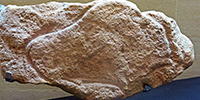 hspace = "10" vspace = "5">
hspace = "10" vspace = "5">
a. It is notable for its stone engravings and tool kit. The site consists mainly of the deposits at abris below a cliff, and is important for the study of the old Magdalenian, or Badegoulian. However much of the material remains unpublished.

Kapova Cave is a famous Russian Palaeolithic cave. It has painted mammoths, rhinos, horses and a bison on its walls. The cave has two levels, the paintings are mainly in the upper level at some distance from the entrance. The charcoal was dated with the 14C method to be 14 680 ±150 years old. Among the animal bones were cave bear bones. Kapova Cave is a complex natural monument with multiple grottos and halls connected by passages on various levels. The walls of the cave are rich in calcite deposits of all kinds of forms and sizes. An underground river flows out of the cave and forms the Blue Lake at its entrance.
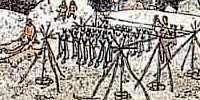
Laugerie Haute is a fundamental site, one of the largest rock shelters in the area, and was excavated by, among others, Lartet, Hauser, Peyrony and Bordes. It bears witness to thousands of years of human occupation spanning from the late Perigordian to the Middle Magdalenian (24 000 - 14 000 BP). Occupation of the site was ended by the collapse of the shelter roof, with several enormous blocks now sealing the archeological levels beneath and creating their present day limits. These archeological levels reveal an abundance of stone tools, a bone and antler industry of impressive quality, as well as artefacts and engraved blocks most of which were found in the uppermost level.
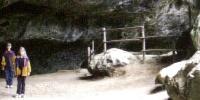
Laugerie Basse is an abri, a rock shelter rather than a cave, on the right bank of the Vézère River, across the bridge from the small tourist town of Les Eyzies. It is a very important gisement. Laugerie Basse is about fifteen metres deep and fifty metres long. The site is made of two rockshelters: the Abri des Marseilles and the Abri classique. Between the Grand Roc cave and the Abri is the museum displaying general information about mobile art. Videos about geology, archeology, the way of life and symbolic expression are available. The excavations carried out during the 1860s by Edouard Lartet did not accurately record the stratigraphy of the site. The stratigraphy was not established until around the First World War. There are four Magdalenian phases, III, IV, V, VI, during the Würm IV, represented in this site. The Laugerie Basse Venus, 'Venus Impudique' (Immodest Venus) was discovered in 1864 by the Marquis Paul de Vibraye. It was the first Venus figure found in France. Many bone, antler, and stone engravings have been found there.
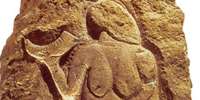
Laussel is a large rock shelter located in the Dordogne valley of France near the town of Laussel, in the municipality of Marquay. Five large carvings were found in what had been a frieze at Laussel, carved onto a limestone block that had fallen from the wall. The most well known carving is known as the Venus of Laussel, originally covered in red ochre.

Proto Lepenski Vir and Lepenski Vir Ia as well as Lepenski Vir Ib-e, II, III is a mesolithic site on the Donau. Lepenski Vir is the name of the great whirlpool in the middle of Djerdap, the Iron Gates Gorge, and the nearby horseshoe shaped shelf between the right bank of the Danube and the steep cliffs of the Koršo hills. Lepenski Vir is a Mesolithic site - that means middle stone age, in this case 8 000 years before the present, after the ice had begun to melt from the glaciers which covered so much of the Northern Hemisphere. It is an open air site, not a rock shelter. It is noted for the trapezoidal houses which had one of the first types of concrete as their foundations. They inhabitants ate fish, aurochs, deer and water birds. Professor Dragoslav Srejović excavated the site of Lepenski Vir.The prehistoric settlement was built on the sunny right bank of the Danube, between the steep slopes of the Koršo hills and the spring high water mark on the low porphyritic rocks which stretch down to the river.
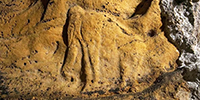
La Grande Grotte de Saint-Front is a little over a kilometre upstream from Domme, on the left bank of the Dordogne. Also known as La Grotte du Mammouth, it contains a number of engravings and sculptures, including a superb Mammoth on a high ceiling.
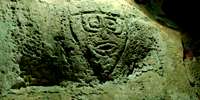
Lene Hara Cave has provided evidence that Timor has been occupied by humans for 35 000 years BP. In May 2009, carved faces were found high in the cave, and have since been dated to 10 000 years. Paintings in the caves of Ile Kére Kére, of which Lene Hara is a part, are believed to be 2 000 to 6 000 years old. In May 2009, carved faces were found high in the cave, and have since been dated to 10 000 BP.

Aboriginal Art of the Kimberleys
This is a record of part of a bushwalking trip from the Berkeley River to the King George River and then to the Drysdale River in the Kimberley region of northern West Australia.
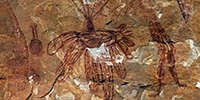
The rock art of Guardian Place, Yam Camp, Shepherd Creek Secret Place, and Easy Dreaming Galleries consists of paintings of Quinkan figures, spirit figures, humans, paintings based on yams, a wallaroo and fruit bats, as well as cupules and other engravings in the sandstone.
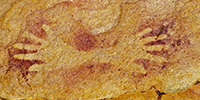
The rock art of Pine Tree Creek, Tied Up Wrist and Wallaroo Galleries consists of paintings of kangaroos and wallabies, eels, people dancing, and Quinkan figures, and hand stencils of two hands at each end of a wrist.
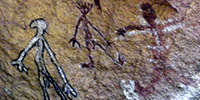
The rock art of Quinkan Corner, the Rock Wallaby Gallery, and Tent Shelter Gallery, consists of Quinkan figures, animal figures of many kinds, but including birds, kangaroos, platypus, and dingoes, as well as human and ancestor figures. It is of great importance in the study of the art of Northern Queensland.
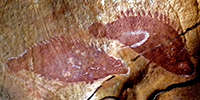
The rock art of the Sandy Creek rock shelter near Laura is part of the huge group of Australian Aboriginal Rock Art known as Quinkan. The pigments used include haematite, and various shades of ochre ranging from red to brown to yellow to white. Subjects include humans, animals, and members of the spirit world.
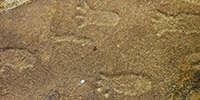
The rock art near Laura Bridge consists of engravings in the sandstone. Subjects include animal tracks, yams, and humanoid figures.
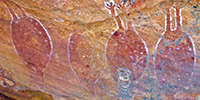
The rock art near Brady Creek consists of both paintings and an important engraving. A painting of a man and woman copulating is repeated in an engraving on a large smooth boulder in the bed of Brady Creek. In addition there are paintings of humans, yam figures, fruit bats roosting, a crocodile, a marsupial, negative hand prints, and spirit figures.
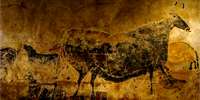
Lascaux Cave is famous for its Paleolithic cave paintings. The paintings are estimated to be 17 300 years old. They primarily consist of images of large animals, most of which are known from fossil evidence to have lived in the area at the time. The cave was discovered on September 12, 1940 by four teenagers. The cave complex was opened to the public in 1948. Rooms in the cave include The Hall of the Bulls, the Passageway, the Shaft, the Nave, the Apse, and the Chamber of Felines. Lascaux II, a replica of two of the cave halls — the Great Hall of the Bulls and the Painted Gallery — was opened in 1983, 200 metres from the original.
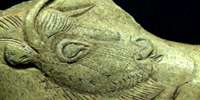
La Madeleine is a rock shelter located in the Vézère valley, in the Dordogne, France. In 1926 the skeleton of a three year old child was discovered, with exquisite shell jewellery, dating from the end of the Magdalenian period. It is a treasure house of art and knowledge about the people of the Magdalenian. Much of this art is on display at the Musée National de Préhistoire, Les Eyzies-de-Tayac.

The cave of La Marche (Municipality of Lussac-les-Châteaux) can be considered as one of the most important archaeological sites for stone engravings. When French scientist Léon Péricard excavated La Marche between 1937 and 1942, he catalogued more than 1 500 slabs of limestone that had been placed carefully on the floor. Many of these have been engraved with human figures. Some can only be seen after careful study, and the painstaking removal of extraneous lines on the drawings made.
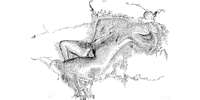
There are two reclining bas relief venus figures on the walls at La Magdeleine des Ablis, which is located near Penne, in Tarn. The engravings and sculptures were found in 1950 by M. Bessac. Dating has been proposed for the engravings as being circa 13 000 BP, but this may be too young a date. Moreover, the works are not homogenous, and a considerable period of time may have elapsed between the engravings. There are also a horse and a bison bas-relief on the walls.

Rock paintings from Namibia in Africa. In Namibia these rock paintings and engravings were completed by San Bushmen. In Namibia these rock paintings and engravings were completed by San Bushmen. The rock engravings, more prevalent in some areas than others, have been found to be from 2 000 to 6 000 years old, and some paintings have been found to be 27 000 years old. The San entered the area about 8 000 years ago. My thanks to Jack for his generosity in sending me these excellent photographs.
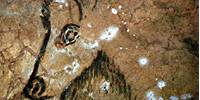
Niaux Cave, or la Grotte de Niaux is one of the most famous prehistoric caves in Europe. It lies in the northern foothills of the Pyrenees, and is located in Ariège, in the valley of Vicdessos, across the valley from the smaller Grotte de la Vache, in an area rich with prehistoric sites. The huge cave entrance, 55 metres high and 50 metres wide, is at 678 metres above sea level. There are more than two kilometres of galleries, with a hundred or more superb paintings from Magdalenian times, most of which are in the famous 'Salon Noir', 800 metres from the entrance. Many of the paintings are done in the classic style of the Magdalenian, outlined in black or red pigment, mostly haematite or manganese dioxide respectively.
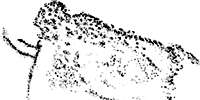
Columbian Mammoth and Bison rock art engravings have been found at the Upper Sand Island rock art site at the San Juan River in Utah, USA. The engravings appear authentic, and show rock varnish and wear indicating that they are from the end of the ice age, about 13 000 - 11 000 years ago, at about the time of the Clovis culture.
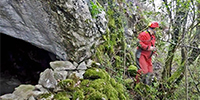
Partisan Cave in Slovenia - based on a chemical analysis of the red colour from one of the cave walls, this may be a remnant of the first Palaeolithic cave painting art in Slovenia. A human incisor belonging to a Neanderthal, which is the first fossil remains of Neanderthal man found in Slovenia, has been found.
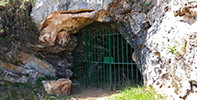
Pasiega Cave in Spain was of mostly academic interest until the discovery that some of the art in the cave may have been put there by Neanderthals. This result has now been discredited. Here is the background to that story, with many drawings of the art of the cave from the old master himself, Breuil.

The Venus of Abri Pataud, as well as the site of Abri Pataud. The Abri Pataud Museum is situated in the only section of the Abri Pataud shelter which did not collapse. On the ceiling, which is in its natural state as a rock face, there is the bas-relief of an ibex, estimated to have been carved about 19 000 years ago. The features are only just discernible in flat lighting, but come into sharp relief when the light is allowed to come in from a sharp angle.
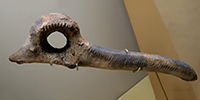
La grotte du Placard is a decorated cave in the commune of Vilhonneur in Charante, 30 km east of Angoulême. It has been extensively researched and has levels dating from the Middle and Upper Paleolithic, especially the Magdalenian and Solutrean.
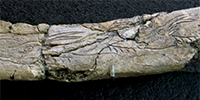
The small cave of Les Eyzies or la Grotte Richard opens above the village of Les Eyzies-de-Tayac, on the right shore of the Beune. Its prehistoric occupation is established in the Upper Magdalenian. It has been largely forgotten, but is an important site.
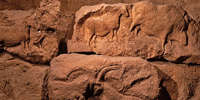
The Roc de Sers sculpted frieze is one of the relatively few examples of parietal art that can be confidently attributed to the Solutrean as it fragmented and fell off the rear wall of the rockshelter into dated archaeological deposits. Sculpture is rare in Upper Palaeolithic parietal art, and, given the relative paucity of Solutrean parietal art in general, Roc de Sers is doubly important as it serves as a benchmark for defining Solutrean artistic form and technique. Abundant evidence has been recovered from three main activity areas across a large part of the rockshelter and associated small cave; a rich classic Solutrean lithic assemblage bears witness to the production of feuilles de laurier, pointes à cran, burins and grattoirs.

The Grotte du Sorcier, or the Roc Saint-Cirq, is one of the sites classified as a World Heritage site by UNESCO among the prehistoric painted caves in the Vézère valley. It was discovered in late 1951. This site contains prehistoric engravings dating from the Magdalenian. There are engravings of humans, including the famous sorcerer, as well as animals (bison, horses and ibex), and linear signs.
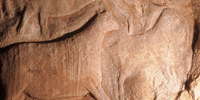
Roc-aux-Sorciers is an Upper Palaeolithic rock shelter site dating to the mid-Magdalenian cultural stage, ca 14 000 BP, made famous by its relief wall carvings. The south-facing rock-shelter is composed of two geologically distinct sections; below is the Abri Bourdois, a classic rock-shelter site beneath a slight overhang, and above is the Cave Taillebourg, a deeper vestibule. The art of Roc-aux-Sorciers is in two distinct categories - a 20 metre long frieze, still standing, not open to the public, and a series of sculptures, formerly on a wall of a collapsed section of the site.
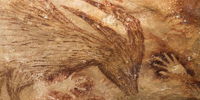
Cave paintings from the Indonesian island of Sulawesi are at least 40 thousand years old, according to a study published this week in the scientific journal Nature. This is comparable in age with the oldest known rock art from Europe, long seen as the birthplace of 'Ice Age' cave painting and home to the most sophisticated artworks in early human cultural history.
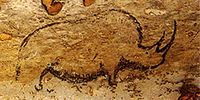
La Grotte de Rouffignac has been known for centuries and was described in 1575 by Francois de Belleforest. It is located in the heart of the Perigord, between Bergerac and Sarlat in the Dordogne region. The site has more than 250 etchings and line drawings dating from the Upper Paleolithic (Magdalenian, more than 13 000 years BP). With a length of over eight kilometres, this cave is one of the largest painted caves in Europe. These galleries were decorated with 158 mammoths associated with woolly rhinoceroses, bison, horses and ibex.
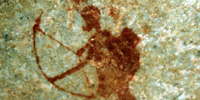
These paintings by the San people of South Africa are on the Sevilla Trail near the Traveller's Rest, a lodge on a farm about 30 km east of Clanwilliam in the Western Cape Province of South Africa. The Bushmen/San were the original inhabitants of Southern Africa and are commonly known as Bushmen or San. They were hunter-gatherers, hunting with bows and arrows, trapping small animals and eating edible roots and berries. They lived in rock shelters, in the open or in crude shelters of twigs and grass or animal skins. They made no pottery, rather using ostrich eggshells or animal parts for storing and holding liquids. For these reasons, animals and nature are central features in the Bushmen's religious tradition, folklore, art and rituals. I am very grateful to Michael Hess for these evocative photographs and text.
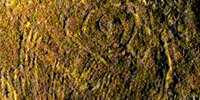
La Grotte de la Vache is important for the complete camp of Magdalenian hunters found, and may be seen almost as it was 12 000 to 15 000 years ago. Weapons, tools, typical game and artworks have been recovered from this small but important site. It was the living quarters for the artists at Niaux Cave, just across the Vicdessos Valley.

The Grotte de Villars or Villars Cave contains galleries of stalactites and earth coloured calcite accumulations, including 17 000 year old prehistoric paintings dating from the same period as those at Lascaux. The slow seepage of water has created some of the most beautiful natural scenery. There are all types of concretions: calcite, thin stalactites, gours, translucent draperies and countless stalagmites. Some of the cave paintings, like those of the rotunda of the horses are covered with a thin layer of calcite that gives them a special blue color.The scene of the bison and the sorcerer is one of the few human representations of prehistoric art.
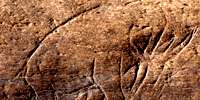
A bone fragment, approximately 13 000 years old, at Vero, Florida with an incised image of a mammoth or mastodon has been announced. This engraving is the oldest known example of Ice Age art to depict a proboscidean (the order of animals with trunks) in the Americas. The bone was discovered in Vero Beach, Florida by James Kennedy, an avocational fossil hunter, who collected the bone and later while cleaning the bone, discovered the engraving.
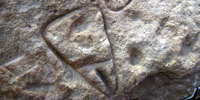
The Vulva in Stone Age Art - The vulva is well represented in Palaeolithic art. It is mostly seen as engravings on stone, bone or ivory. The representation is obviously a well known one that has become abstracted to the point where it is often no more than an oval or circle with a single mark at its centre or at its lower edge. Although many examples are from Europe, and from the upper Palaeolithic, it occurs over a broad time range, and a very large area, including not just Europe, but Australia as well.
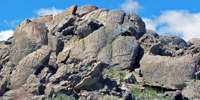
Winnemucca Lake petroglyphs discovered in western Nevada are at least 10 500 years old, making them the oldest rock art ever dated in North America. On the west side of Nevada's dried-up Winnemucca Lake, there are several limestone boulders with deep, ancient carvings; some resemble trees and leaves, whereas others are more abstract designs that look like ovals or diamonds in a chain. The true age of this rock art had not been known, but a new analysis suggests these petroglyphs are the oldest North America, dating back to between 10 500 and 14 800 years ago.

The Mount Yarrowyck Nature Reserve near the junction of the Armidale Road and Thunderbolts Way protects an Aboriginal cave painting site and much of the natural environment of Mount Yarrowyck. The paintings are probably several hundreds of years old. The tracks, circles, short lines and dots may remind you of birds' feet, people, lizards and even birds' eggs. However an Aboriginal elder, the late Victor Shepherd, was sure that the paintings were of a bird that fed on the ground. Ground birds were represented by their feet alone. He said the toes look too short and thick to be an emu. The paintings must be of the Plains Turkey, the Bustard.

Zaraysk or Zaraisk or Зарайск is part of the Kostenki / Avdeevo group, and is the northenmost example of this culture. The site dates to between 22 000 and 16 000 years ago. The inhabitants were living in a peri-glacial tundra environment, but could call on the rich flint and animal resources of the area at that time. Wood was scarce, but flint, bone and ivory were plentiful, so that raw materials for food, fuel and tools were readily available. The naturalistic statuette of a bison made from a mammoth tusk was the first significant discovery to place Zaraysk on the same level with the best known Palaeolithic sites of Europe.
























 The archaeological cave site of El Mirón is located in the Rio Asón valley of eastern Cantabria, Spain. The cave opening is about 260 metres above sea level, and the cave opening is about 13 metres high, 8-16 metres wide, and 120 metres deep. A red deer stag shoulder blade found there bears the engraved image of the head, neck and part of the dorsal line of a red deer hind. El Mirón is remarkable for its long occupation history and thus for its long unbroken sequence of history and prehistory of Cantabria, Spain. The site includes human occupations between the Middle Paleolithic (circa 41 000 years ago) to 1400 AD, including Mousterian, Early Upper Paleolithic, Solutrean, Magdalenian, Azilian, Mesolithic, Neolithic, Chalcolithic, and Bronze Age deposits.
The archaeological cave site of El Mirón is located in the Rio Asón valley of eastern Cantabria, Spain. The cave opening is about 260 metres above sea level, and the cave opening is about 13 metres high, 8-16 metres wide, and 120 metres deep. A red deer stag shoulder blade found there bears the engraved image of the head, neck and part of the dorsal line of a red deer hind. El Mirón is remarkable for its long occupation history and thus for its long unbroken sequence of history and prehistory of Cantabria, Spain. The site includes human occupations between the Middle Paleolithic (circa 41 000 years ago) to 1400 AD, including Mousterian, Early Upper Paleolithic, Solutrean, Magdalenian, Azilian, Mesolithic, Neolithic, Chalcolithic, and Bronze Age deposits.







 Tuc d'Audoubert, 640 metres long, may only be accessed via the stream, the Volp, which includes two impassable siphons. The cave of Tuc Audoubert was discovered by the sons of Count Henri Bégouën in 1912. Having been to Mas d'Azil, during the summer holidays of 1912, July 20, they decided to explore the resurgence of Volp using a raft they made, and thus discovered the cave of Tuc d'Audoubert and the first engravings. A prehistorian, Emile Cartailhac, a family friend, was called immediately and authenticated the drawings. On 10 October, through a narrow gap which became known as the catflap, with the help of their friend François Camel, they penetrated the upper galleries at the bottom of which awaited the clay bisons!
Tuc d'Audoubert, 640 metres long, may only be accessed via the stream, the Volp, which includes two impassable siphons. The cave of Tuc Audoubert was discovered by the sons of Count Henri Bégouën in 1912. Having been to Mas d'Azil, during the summer holidays of 1912, July 20, they decided to explore the resurgence of Volp using a raft they made, and thus discovered the cave of Tuc d'Audoubert and the first engravings. A prehistorian, Emile Cartailhac, a family friend, was called immediately and authenticated the drawings. On 10 October, through a narrow gap which became known as the catflap, with the help of their friend François Camel, they penetrated the upper galleries at the bottom of which awaited the clay bisons!


 Vogelherd cave is located on the edge of the Lone valley, about 1 km northwest of Stetten and northeast of the Alb-Donau county (Alb-Donau-Kreis). Vogelherd cave is a very scenic place and well worth a visit, as indeed is all of the Lone valley. The cave is not visible from the road and one must first walk over a ridge to gain access to the three entrances on the edge of the Lone valley. The cave covers an area of 170 square metres. This extremely important site, rich in finds, was first discovered when Stone Age artefacts turned up from a badger's burrow. The actual size of it only became apparent after the excavations by Gustav Riek in the summer of 1931. The finds range from the Middle Palaeolithic to modern times. The world-renowned ivory carvings originate from the Middle Aurignacian period.
Vogelherd cave is located on the edge of the Lone valley, about 1 km northwest of Stetten and northeast of the Alb-Donau county (Alb-Donau-Kreis). Vogelherd cave is a very scenic place and well worth a visit, as indeed is all of the Lone valley. The cave is not visible from the road and one must first walk over a ridge to gain access to the three entrances on the edge of the Lone valley. The cave covers an area of 170 square metres. This extremely important site, rich in finds, was first discovered when Stone Age artefacts turned up from a badger's burrow. The actual size of it only became apparent after the excavations by Gustav Riek in the summer of 1931. The finds range from the Middle Palaeolithic to modern times. The world-renowned ivory carvings originate from the Middle Aurignacian period.



 A number of world-wide famous caves, such as the Geissenklösterle, Brillenhöhle, Grosse Grotte, Sirgenstein and Hohle Fels cave, can be reached from Blaubeuren on a signed hiking path. I visited the area in the summer of 2018, and have added many photographs and a lot of extra text. A number of superb carvings of animals have been found at Geißenklösterle, and the Venus of Hohle Fels is the oldest venus figurine ever found.
A number of world-wide famous caves, such as the Geissenklösterle, Brillenhöhle, Grosse Grotte, Sirgenstein and Hohle Fels cave, can be reached from Blaubeuren on a signed hiking path. I visited the area in the summer of 2018, and have added many photographs and a lot of extra text. A number of superb carvings of animals have been found at Geißenklösterle, and the Venus of Hohle Fels is the oldest venus figurine ever found. 

 hspace = "10" vspace = "5">
hspace = "10" vspace = "5">

































